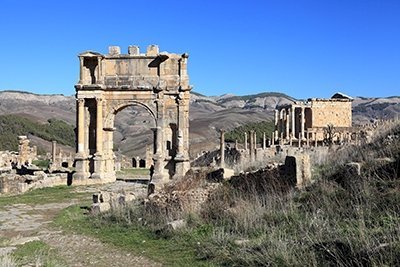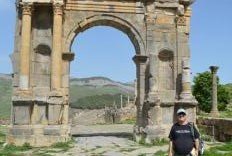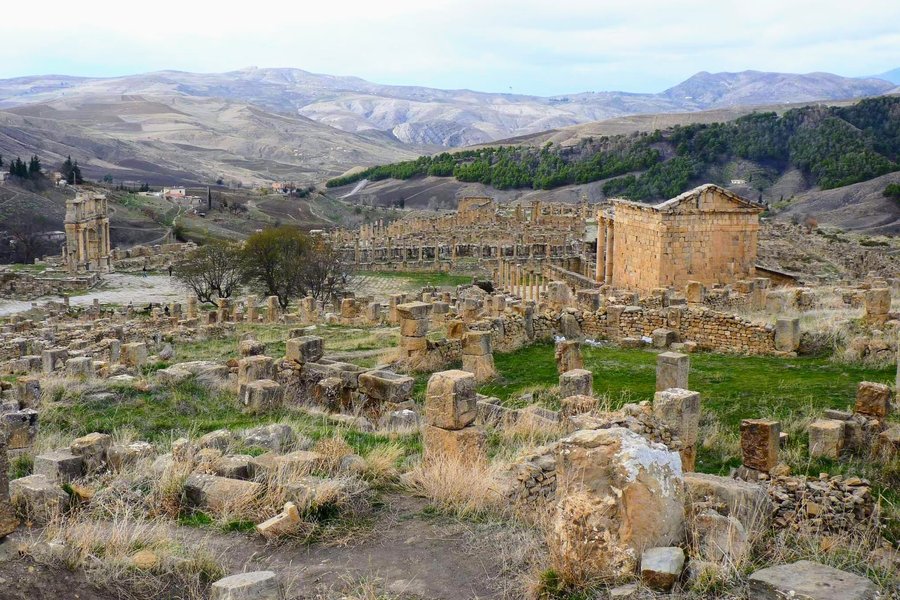Algeria
Djémila
Djémila shows the unique adaptation of Roman architecture to a mountain environment.
This mountain village has some of the best-preserved and most beautiful Roman ruins in North Africa. They belong to a Roman colony known at the time as Cuicul. The remains include a theatre, two fora, temples, basilicas, arches, streets, and houses. Also, impressive mosaics have been uncovered.
Community Perspective: Constantine and Setif are the major cities from where you easily can visit Djémila as a half-day trip. The site is covered in flowers in Spring.
Site Info
Official Information
- Full Name
- Djémila (ID: 191)
- Country
- Algeria
- Status
-
Inscribed 1982
Site history
History of Djémila
- 1982: Inscribed
- Inscribed
- Type
- Cultural
- Criteria
- iii
- iv
Links
- UNESCO
- whc.unesco.org
- Related
-
- en.wikipedia.org — Wiki on Djémila
All Links
UNESCO.org
- whc.unesco.org — whc.unesco.org/
Related Resources
- en.wikipedia.org — Wiki on Djémila
Community Information
- Community Category
- Archaeological site: Ancient Rome
Travel Information
Recent Connections
-
Works by Nobel Prize winning authors
"Le Vent a Djemila" (1938)- essay by Al… -
Built in the 2nd century
"Djémila is an outstanding example of .… -
Triumphal Arches
Arch of CaracallaSee whc.unesco.org
Connections of Djémila
- Trivia
-
-
In the Louvre
Door lintel
-
- History
-
-
Ancient Roman colonies
The city was initially populated by a colony of Roman soldiers from Italy, and eventually grew to become a large trading market. (wiki)
-
- Architecture
- World Heritage Process
-
-
Perfect Inscriptions
1982
-
- Religion and Belief
-
-
Early Christianity
In the southern quarter, Christianity was implanted at an early date (the bishop Pudentianus of Cuicul is noted from 255). (AB Ev) The site has also been marked by Christianity in the form of several cult buildings: a cathedral, a church and its baptistry are considered among the biggest of the Paleochristian period. (unesco website)
-
- Constructions
-
-
Baths
Vestiges of monuments that have marked the expansion of the city to the south are also included. They comprise private dwellings and public buildings such as the Arch of Caracalla, a theatre, baths, basilicas and other cult buildings. (AB ev) -
Macellum
In the central quarter (AB ev) -
Theatres and Opera Houses
Roman theatre -
Triumphal Arches
Arch of CaracallaSee whc.unesco.org
-
- Timeline
-
-
Built in the 2nd century
"Djémila is an outstanding example of ... (an) architectural ensemble illustrating a significant stage in Roman history of North Africa, from the 2nd to the 6th centuries". (It)is an " ancient Roman colony founded during the reign of Nerva (96 - 98 A.D.)".Around the beginning of the 3rd century, it expanded beyond its ramparts with the creation of the Septimius Severus Temple, the Arch of Caracalla, the market and the civil basilica." (AB)
-
- Literature & Film
-
-
Works by Nobel Prize winning authors
"Le Vent a Djemila" (1938)- essay by Albert Camus from the collection "Noces". Camus muses on death - inspired by the ruins!.
-
News
No news.
Recent Visitors
Visitors of Djémila
- AC
- Adrian Turtschi
- Alexander Barabanov
- A. Mehmet Haksever
- Ask Gudmundsen
- Atila Ege
- Bill Maurmann
- Boj
- Bram de Bruin
- edstar500
- Emili Xaus
- Eva Kisgyorgy
- George Gdanski
- Gernot
- Harry Mitsidis
- Iain Jackson
- Jon Opol
- Juha Sjoeblom
- Loic Pedras
- Luis Filipe Gaspar
- Maciej Gil
- Maciej Gowin
- Martin
- Michael Novins
- michaelsballard
- Mikko
- Milan Jirasek
- Miloš Tašković
- Nihal Ege
- Pincze
- pressdm
- Roman Bruehwiler
- Solivagant
- Sutul
- Szucs Tamas
- Thomas Buechler
- Thomas van der Walt
- Timothy C Easton
- Vsacan
- Weecheng
- wendy007
- Wo_ko
- Zoë Sheng
Community Reviews
Show full reviews
Site visited December 2013. The Arabic name of the ancient Roman city of Cuicul is Djémila which means ”beautiful”. The site really matches its newer name because it is probably the most beautiful and scenic of all the Roman sites in Algeria. I think it is also one of the top three Roman sites of Africa.
Cuicul was an ancient Roman colony and a military garrison founded in the 1st century. It is built on an altitude of 900 metres on a narrow triangular plateau. The city is well adapted to the mountainous location at the confluence of two rivers. During the 3rd century the city expanded beyond its original location. A New (Severan) Forum was built to the southern end of the city, and a theatre was built outside the city walls because there was not enough space inside the walls. In the 4th century the city grew even further with so called Christian quarters.
After the entrance gate, which is the highest point of the site, are the Christian quarters with a circular Baptistery building and the Great Baths. On top of the hill opens a view over the ancient city with some nice mountain landscapes on the background. In the centre of Djémila is the Severan Forum with Temple of Severan Family and the Triumphal Arch of Caracalla. To the east from the Severan Forum, hidden behind a hill, is a steep theatre for 3000 spectators. To the north from the Severan Forum the colonnade …
Keep reading 0 comments
Setif is a good headquarter from where to explore the Roman ruins of Djemila, the antique
Roman settlement of Cuicul. Select a trustworthy driver and start, half a day is enough for the 35km distance. For the very first time I had to register with the local police at the entrance gate, I found it a little exagerated, but locals always say that it's for security reasons. Djemila in spring time is unbelievable beautiful. It is the symbiosis of the flowers with the ruins that was so unique. I was told that April/May is the best season to come here. But I can also feel the Sahara dust in the air. Besides of the Basilica, the Arc and various Temples, there are Baths and a very interesting museum with famous mosaic tiles like the Toilet of Venus. Its by far the best museum I have seen in Algeria. On the way back to Setif the police insists of an car escort out of Djemila, a bit exagerated I guess as there were really no security concerns.
Keep reading 0 comments
This is one of the finest roman cities that you can visit. The forum, Severan temple, arch and theatre are impressive. The setting is is in the hills with a triangular city layout. The mosaics in the museum are also among the best you will see.
Keep reading 0 comments